|
|

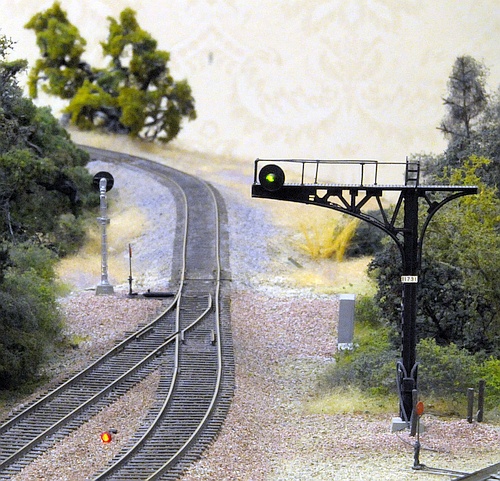
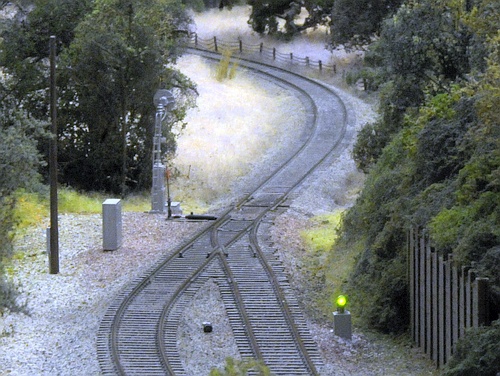
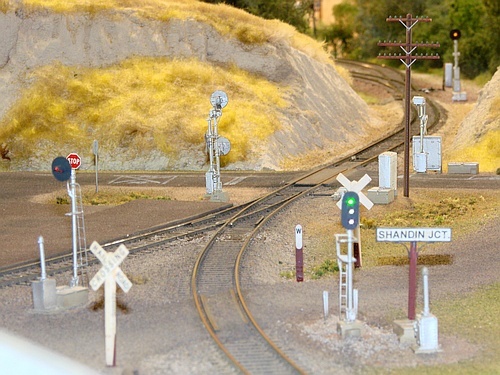
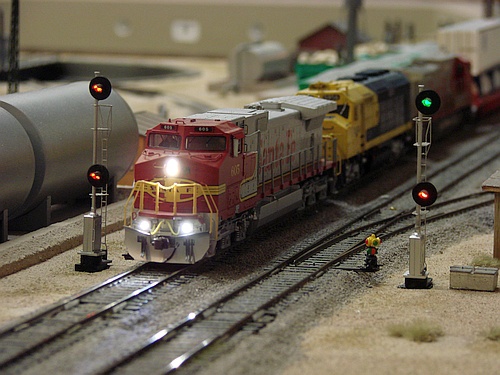
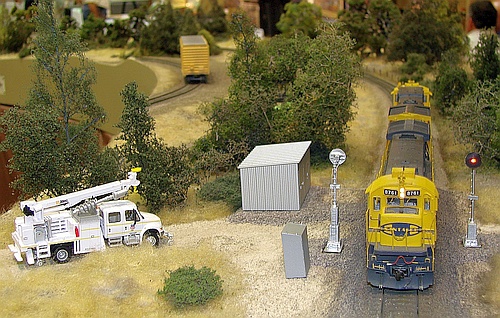

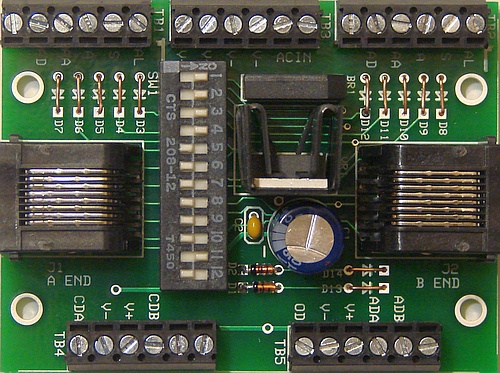

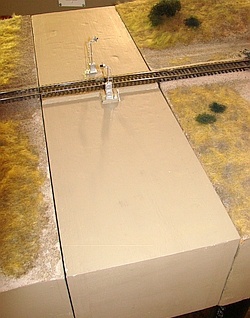





Modular Signal System
I invented the Modular Signal System (MSS) to enhance my Free-mo modular model railroading activities.
Early on, I had outfitted my Glen Frazer module with signal animation controllers that detected the
presence of a train to make the local signal display red (occupied). Once the train had passed and the
sensor was clear, the controller used timer circuitry to set the signal to yellow (approach) after a few
seconds, and then back to green (clear) after a few more seconds. The problem was the hardware had
no awareness of trains approaching the signal, so the indication behavior was less than realistic - when
the train hit the sensor, the signal would go from green to red with no yellow approach indication in between.
The MSS grew from a basic concept first proposed by fellow Free-mo modelers Chris P. and Michael M.
The output from a current detector on the main track would extend in either direction to signals at each
end of a block, which would display occupied (red) when the detector was activated. I expanded that
premise to support approach (yellow) and advance approach (flashing yellow, or a second solid yellow),
using an occupancy bus structured to be modular and reversible just as Free-mo modules are.
I've invested hundreds of hours developing and promoting this system. Once I'd tested
it in NorCalF layouts to verify it worked, I wrote an article to freely share my invention with
the model railroading community (Rail Model Journal, February 2005). I also developed my
Occupancy Bus Utility Board (OBUB), which simplified the wiring so anyone can install the MSS in a
module or layout with minimal effort (the OBUB is currently not available).
Today, Free-mo groups across the continent use the MSS in their modular layouts.
From its humble beginnings, I'm quite pleased with how successful and popular the MSS has become!
To learn more, visit the dedicated MSS website, including the standard
developed by myself and other manufacturers who offer MSS compatible products.
I invented the Modular Signal System (MSS) to enhance my Free-mo modular model railroading activities.
Early on, I had outfitted my Glen Frazer module with signal animation controllers that detected the
presence of a train to make the local signal display red (occupied). Once the train had passed and the
sensor was clear, the controller used timer circuitry to set the signal to yellow (approach) after a few
seconds, and then back to green (clear) after a few more seconds. The problem was the hardware had
no awareness of trains approaching the signal, so the indication behavior was less than realistic - when
the train hit the sensor, the signal would go from green to red with no yellow approach indication in between.
The MSS grew from a basic concept first proposed by fellow Free-mo modelers Chris P. and Michael M.
The output from a current detector on the main track would extend in either direction to signals at each
end of a block, which would display occupied (red) when the detector was activated. I expanded that
premise to support approach (yellow) and advance approach (flashing yellow, or a second solid yellow),
using an occupancy bus structured to be modular and reversible just as Free-mo modules are.
I've invested hundreds of hours developing and promoting this system. Once I'd tested
it in NorCalF layouts to verify it worked, I wrote an article to freely share my invention with
the model railroading community (Rail Model Journal, February 2005). I also developed my
Occupancy Bus Utility Board (OBUB), which simplified the wiring so anyone can install the MSS in a
module or layout with minimal effort (the OBUB is currently not available).
Today, Free-mo groups across the continent use the MSS in their modular layouts.
From its humble beginnings, I'm quite pleased with how successful and popular the MSS has become!
To learn more, visit the dedicated MSS website, including the standard
developed by myself and other manufacturers who offer MSS compatible products.
Left: The west end of my Glen Frazer module has the earliest
working signals in the Free-mo universe. That beautiful cantilever deserved to have a working signal head!
Below: The signals at the east end of my Glen Frazer module.
(I also helped scenic Jere I.'s Hearst Creek module, background.)
working signals in the Free-mo universe. That beautiful cantilever deserved to have a working signal head!
Below: The signals at the east end of my Glen Frazer module.
(I also helped scenic Jere I.'s Hearst Creek module, background.)
Below: One of the most complex MSS installations is on Gary Green's
Shandin module, which consists of a wye and 3-track reverse loop.
Below: Here is a double-track MSS installation. Each track has its
own dedicated occupancy bus so the signals operate independently.
Below: The "signal-mo" is a very small module (e.g., 12" long) with working MSS signals, used to easily add a signal block boundary at any point
in a Free-mo layout. From left to right: A scenery-ready signal-mo under test; the electricals packed into the small frame; scenicked and in use.
in a Free-mo layout. From left to right: A scenery-ready signal-mo under test; the electricals packed into the small frame; scenicked and in use.
Below: An MSS-enabled double-track signal bridge on a signal-mo.
Below: My OBUB-3 (Occupancy Bus Utility Board, 3rd generation).
It can be used in any type of MSS node and includes a 12-volt
regulator to power MSS electronics like detectors and signals.
It can be used in any type of MSS node and includes a 12-volt
regulator to power MSS electronics like detectors and signals.
-- About
-- Contact
-- Diesels
-- Links
entire website copyright Gregg Fuhriman
created with CoffeeCup Visual Site Designer
created with CoffeeCup Visual Site Designer
-- Layouts
-- Modules
-- Signalling









